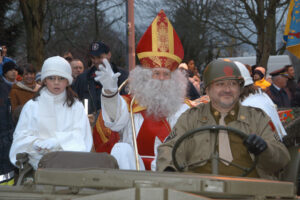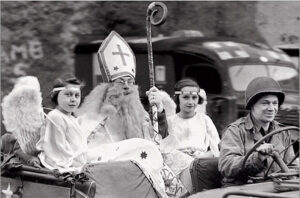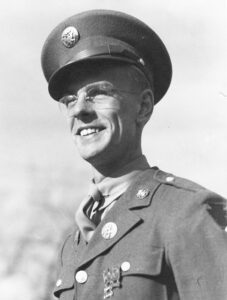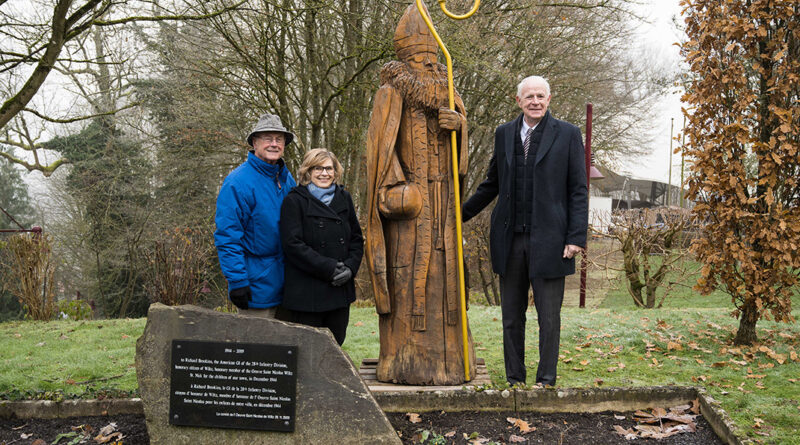The American St. Nick
A Christmas favor for a friend changes lives — on two continents
By John Addyman

He was just doing a favor for a friend.
And it changed his life.
On Dec. 4, 1944, in the village of Wiltz, Luxembourg, the U.S. Army’s 28th Division — the Keystone Division was getting resupplied and getting a respite from stubborn fighting in the Hurtgen Forest in Germany.
Dick Brookins, 22, a Rochester native, was a cryptographer in the signal corps. He was thankful for a little time away from the shelling. The Germans had left in haste with the village untouched, but Brookins couldn’t ignore the plight of the villagers.
Eighty years later, sitting in his Webster kitchen, Dave Brookins, 79, Dick’s son, describes the beginning of how his dad’s and his family’s lives changed that day in 1944.

“Harry Stutz, one of dad’s friends, spoke French and learned directly from townspeople how lousy their lives were under the German occupation,” Dave explained. “There was not enough food for them and the army. People were struggling, but they were happy to be liberated.
“St. Nicholas Day was coming. It was a big day for them and they wanted to celebrate, for the children primarily. They hadn’t been able to do that. It was not permitted while the Germans were there. They wanted to do St. Nicholas Day, but they didn’t have anything for the kids.”
Stutz, who was Jewish and had no clue about how to arrange a Christmas celebration in a foreign country, nevertheless told the townspeople, “I think we can do something.”
“He rounded up his buddies and gave everyone a job,” Dave said. “He wanted one of our guys to be St. Nicholas. Normally, it was someone in the town who did that, but Harry wanted the GIs to really participate in this. That’s when he told my dad, ‘I need your help.’
“My dad said, ‘I’m not going to do that. I don’t know anything about playing Santa Claus. I’ll screw it up. I don’t want to embarrass myself or the GIs.’ But Harry was pretty persuasive and had a hook: ‘You’re the same size as the local priest; you’ll fit in the vestments.’ Two nuns at the convent had a costume for him to wear.”
On Dec. 6, a parade wound through town, featuring Dick Brookins as St. Nicholas riding in a Jeep. He had a white beard attached, a mitre on his head, a vestment and cape and a staff. Two angels flanked him in the back seat.

Nuns prepared kids for traditional songs and dances and the parade visited the girls’ school, the boys’ school and the old folks’ home. GIs emptied their mess kits and packages from home for candy and chocolate. Brookins handed out the candy, the kids were served cocoa made from the donated chocolates and townspeople cooked up doughnuts to hand out. Everywhere there were smiles.
For one day, a four-year nightmare seemed a distant memory. This American, in the raiment of St. Nicholas, had reborn the celebration of Christmastide.
It was splendid.
And the people of Wiltz remembered.
“Luxembourgers, even today, say, ‘We cannot believe you GIs came 3,000 miles from your homes and liberated us from monstrous tyranny. And then, in your spare time, you put on a party for our kids…who does that?’” Dave Brookins said.
Days after St. Nicholas Day, the Battle of the Bulge began and Wiltz was 80% destroyed by the fighting. The 28th Infantry held the line while George Patton’s tanks and the 101st Airborne came in to relieve Bastogne. Then the GIs were resupplied again and ended up in France.
For Dick Brookins, the memory of that day in 1944 faded as the war ended and he started living the rest of his life.
Until August of 1977 — 30 years later.

Dick received a long, handwritten letter from Jean Schweig in Luxembourg, asking if he would honor the town by coming back and playing St. Nicholas again.
“What the GIs did, putting on a party for the kids, was very nice,” Dave explained, “but the Luxembourgers took that to heart and it became part of their culture. They are not going to forget it. In fact, 30 years later, they were going to make a real big deal out of it. They wanted everybody in the world to know about it.”
“The letter just blew Dad’s mind,” Dave remembered. “He told us, ‘I almost forgot about this thing.’ They did this on one day. A lot of the detail was fuzzy.
“He talked with my mom and asked, ‘How do you say ‘No’ to something like this? We’re able to do this. I think we ought to go. But also, I can’t do this and come back and try to explain this to people. I want the kids to come with us.’”
Dick went back to Wiltz with his wife, three sons and a daughter. Sons Don and Terry were film photographers at TV stations in Rochester and Denver and they shot film that became stories in their local markets.
Before the trip, Dick explained to the family that “This is going to be a big deal. Be prepared to do whatever is important to these people. We have to make sure we represent the GIs the best we can.”
“We landed in Luxembourg City and had a motorcade to Wiltz. We were wined and dined. Every night was a different banquet. We ate some strange food. It was quite a party,” Dave said. “Women who had been children in 1944 approached Dad and put their hands on either side of his face” in a joyous heartfelt hug. They did this every time he went back to Wiltz and was recognized for the next 40 years.

“That trip made an impression on all of us,” Dave said after watching the village react to his dad. “At the welcoming banquet, I opened my mouth and promised, as long as Wiltz wants to celebrate this story, there will be a Brookins at the event. I’ve got a son and three grandsons, somebody will be there. It’s part of our responsibility. It’s an honor to my dad and to the guys of the 28th Division signal company. The least I can do is to go back and be there for them. People get really excited when they see us. We’ve been going back ever since.”
Dick Brookins went back to Wiltz in 1981 on a tour with GIs. In 1984, Dick and his family led the 40th anniversary trip; in 1994, the 50th anniversary now included all the grandchildren and spouses — 19 people in all. The five-year rotation included trips in 1999 and 2004, the last time Dick, who was now 82, played St. Nicholas.
“St. Nicholas is a demanding job,” Dave said. His dad had to get into costume to attend an early-morning mass, then the parade, handing out candy to 1,500 kids, marching to the Wiltz Castle to the old folks’ home and to the hospital to hand out candy. In the evening there was a banquet “and about midnight you finally get to bed.”
Dick was the grand marshal for the 2009 and 2014 parades. He died in 2018 at the age of 96.
Wiltz pulled out the stops to honor Dick Brookins in 2024, issuing two stamps, unveiling a statue of the American St. Nicholas and honoring him with the Military Merit Cross of Honor.
Dick Brookins was raised as a kid in Rochester who loved to join things, to have lots of friends and to often emerge as a leader. He was legally blind in one eye yet found a job in the Army and stepped into a role that has become part of the culture in a village 3,000 miles away.
“He did all that because a friend asked him to do it,” Dave said. “When people told him how important it was for him to be St. Nicholas, he recognized the significance. He was willing to do whatever he could. The whole story was important to Luxembourg, to the Americans, to do something decent to help people who had gone through unspeakable conditions for years.”
The celebration of St. Nicholas (“Kleeschen”) in Wiltz is highlighted by children unwrapping sweet gifts like chocolate and the traditional Boxemannchen gingerbread men.
On a snowy day in 1944, Dick Brookins and the 28th Infantry Division delivered the gift of that celebration to people who needed their hearts mended and hope instilled.
Dick was just doing a favor for a friend.
It ended up being a gift for his life.
More About Dick Brookins
For more information about Dick Brookins and the American St. Nick read “American St. Nick: A True Story of Christmas and WWII That’s Never Been Forgotten,” by Peter Lion available at amazon.com (https://shorturl.at/jUAHi) or watch a past PBS presentation online (https://shorturl.at/AUDvX).

